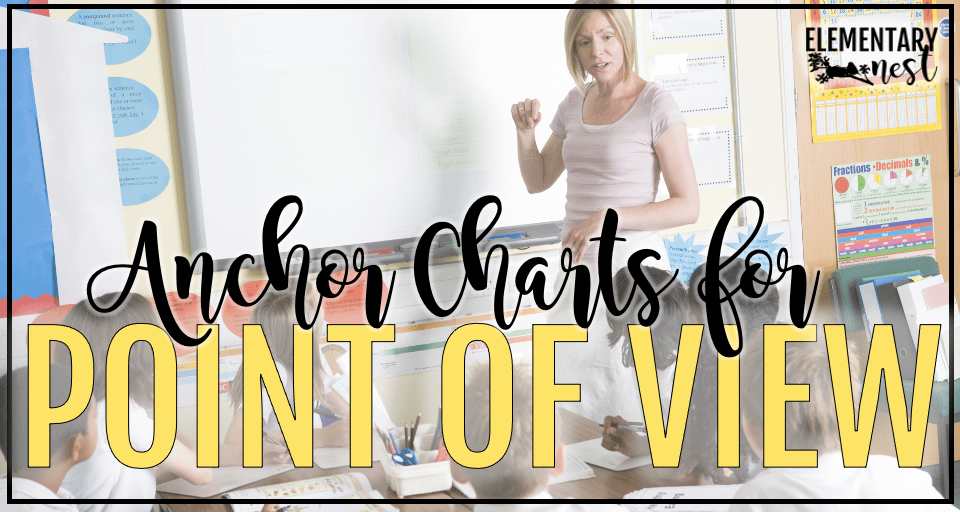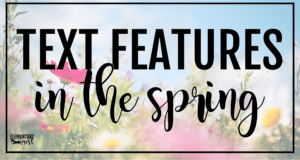
Do you ever struggle to get through the “point of view” lesson plan with your students? Teaching an unfamiliar concept can be tricky, so it’s important to use visuals and interactive learning tactics. Anchor charts create a great visual teaching tool and are easy for students to reference and remember. Here, we’ll discuss 3 anchor chart ideas that will help your students better understand points of view!
Anchor Chart for Definition

Firstly, you will need an anchor chart to define the concept. Title your anchor chart and list the points of view you will be teaching. Most grade levels only need 1st and 3rd person, but if your students are ready for it, you can include 2nd person narration, too!
Your anchor chart will need to have clear visuals for 1st-ME, 2nd-YOU, and 3rd-HE/SHE or THEY. Define each point of view with a simple and clear definition. Then, you can add other pronouns that are found within the points of view.
Leave this anchor chart up for students to reference while they are learning this skill.
Anchor Chart for Process

Next, you will want a process anchor chart. This will show students how to determine the point of view when they are reading. The steps can be written in simple terms, like a short list.
- Read the passage.
- Cross out (or ignore) the [dialogue].
- Focus on the pronouns [used by the narrator].
Also, I like to add clarifying language for easily confused concepts. For example, under dialogue, I added internal thoughts and spoken words, so that students know they aren’t focused on the characters talking. It is important for them to know that they are only analyzing the narration, who is telling the story.
At the bottom, there is room for pronoun lists to remind students which pronouns will be present for each point of view.
Similarly, leave this chart up as a reference chart.
Anchor Chart for Application

Additionally, you will need an anchor chart for applying the skill. A simple T-chart will do if you are using 1st and 3rd persons. After mini-lessons defining the point of view and learning how to identify it, have students read a text or passage on their own or with a partner. Students can record the title of their text and evidence of the point of view on a sticky note. Then, the sticky note will be placed in the correct column. When you all come back together as a whole-group, have an interactive discussion “checking” each example. Do this activity several times throughout the unit so that your students have multiple opportunities to confirm understanding or redirect misconceptions.
This chart can be used again and again as your students are learning point of view. In fact, it can be left up all year, and students can add to it whenever they read a new book, with you drawing attention to it and “checking for accuracy” in mini-lessons throughout the year.
Print or Project Anchor Charts

Luckily, if you’re short on time or not as enthusiastic about making anchor charts, you can use printable or projectable anchor charts from my ELA units! Students can clip these into their reading binders, glue them into their notebooks or you can display them on your bulletin boards! Easy peasy!
Lastly, some final tips for anchor charts-
- Don’t forget to laminate them! You can use them over and over again!
- Use a magnetic towel bar to hang/display your anchor charts on your whiteboard! Simply hole punch and add binder rings or use large binder clips. {Affiliate Link to Amazon}
- Anchor charts are teaching tools. The more interactive they are, the more students will benefit!
- Sticky Notes are your friends. They make anchor charts endlessly accessible.
- You can store your Printable Anchor Charts on a binder ring and hang them or store them in a place where students can always reference them!
Want a free Point of View activity?

FREE POINT-OF-VIEW ACTIVITIES FOR 1ST AND 2ND GRADE
Get these two activities sent directly to your inbox. In first grade, students are asked to simply identify who is speaking or narrating parts of a story. When students move to second grade, they are asked to identify how characters feel about certain events. You’ll receive two freebies that cover both, one today and one later this week!
No-Prep Point of View Resources You May Enjoy:




If you’re looking to teach point of view and don’t want the added prep, I have resources for you! Each unit contains lesson plans, anchor charts, graphic organizers, comprehension passages, interactive notebook pieces, task cards, and an assessment! Click the links for a closer look!















